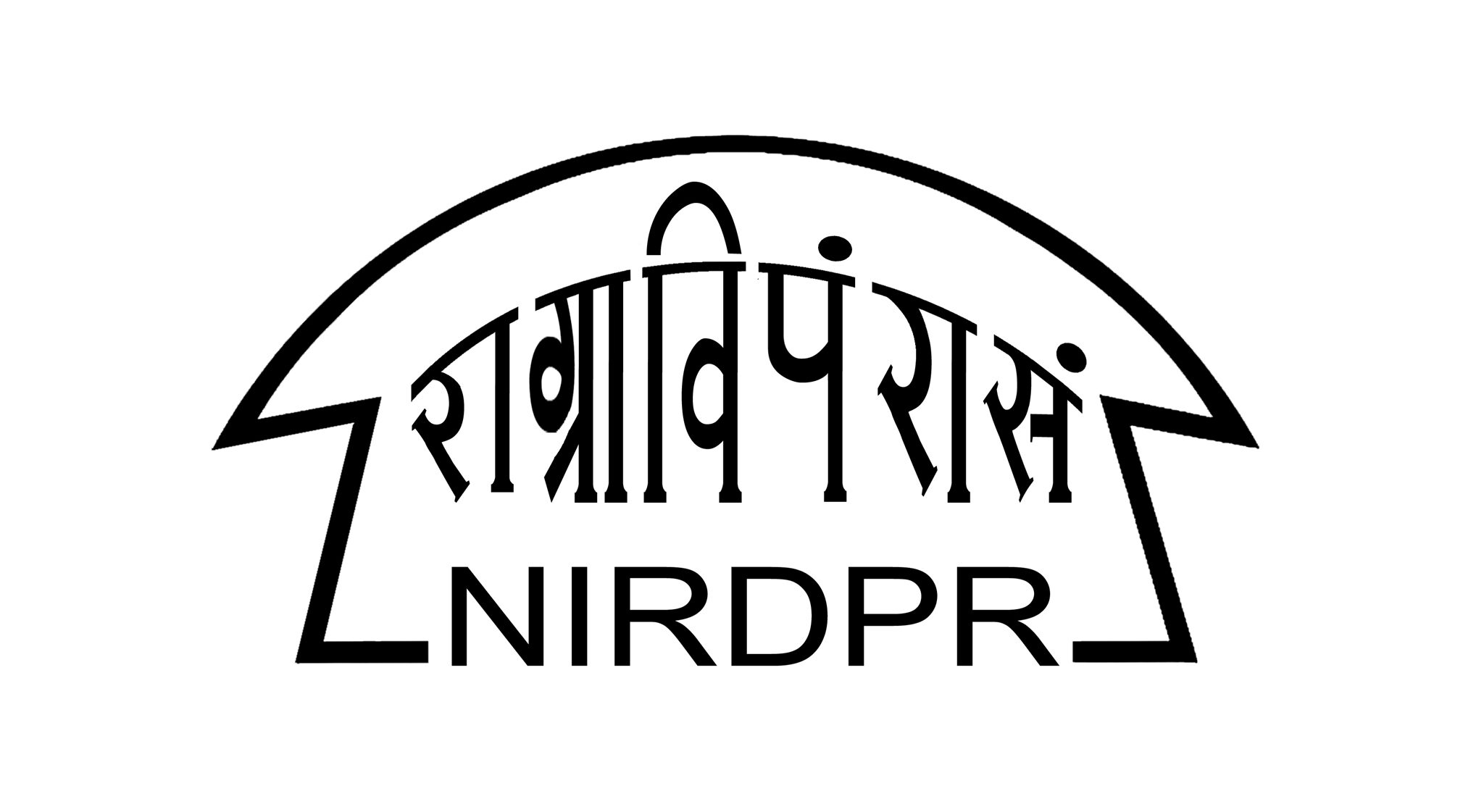
COVER STORY: Social Accountability Tools for Good Governance Practices
Training on the Role of SBCC in Rural & Human Development for SIRDs
NIRDPR Observes 66th Mahaparinirvana Diwas
CAS, CEDFI Organise Training Programme on Strategies for Formalisation of Rural Informal Sector
Good Governance Week: Prashasan Gaon Ki Aur Campaign
Orientation by EPW Research Foundation on India Time Series Database
NIRDPR Official Attends International Programme on Management Strategies for Sustainability of CFIs
Five-day training Programme on Farmer Producer Organisations in Bamboo Sector
CDC, CPGS Organise Workshop on FDP for Audio-visual Means for Case Studies and Best Practices in RD&PR
NIRDPR Hosts Workshop on Sustainable Use of Biodiversity at the Local Level
COVER STORY:
Social Accountability Tools for Good Governance Practices
Good Governance Day is observed in India annually on the 25th of December, the birth anniversary of former Prime Minister Atal Bihari Vajpayee. Good Governance Day was established in 2014 to increase awareness among Indians regarding accountability in government.
There is growing recognition that citizens have an important role to play with regard to ensuring the accountability of public officials, improving public service delivery and ensuring good governance. Social accountability, therefore, has become an attractive approach to both the public sector and civil society. It helps in improving governance processes, service delivery outcomes, and making appropriate resource allocation decisions. Over the last two decades, there have been many examples of citizens making their voices heard and engaging in improving governance. There are examples of public officials who have also shown that it is possible to provide good governance in collaboration with the public. This has led to governance becoming more open and responsive than it used to be.
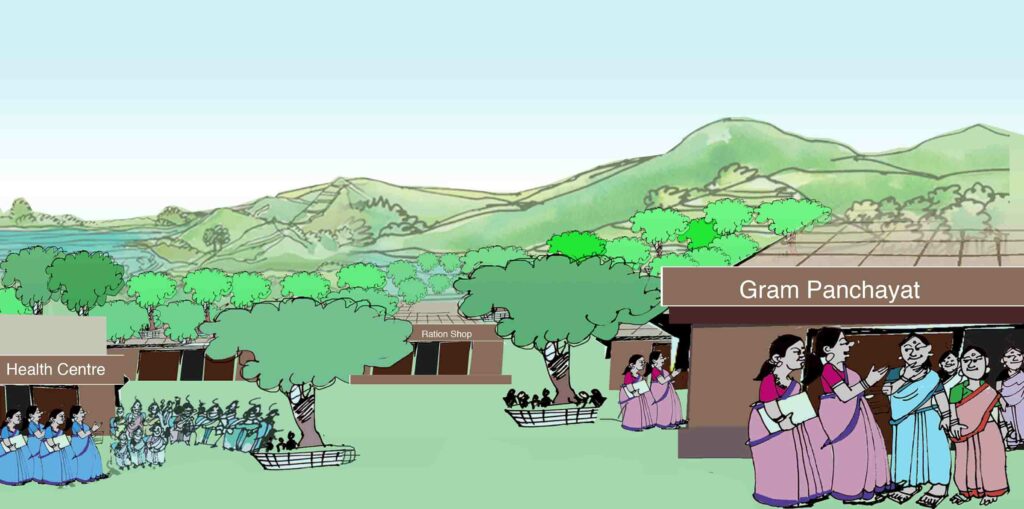
Definition of Accountability
The word accountability means the responsibility of being answerable for an action. In the context of governance, accountability is defined comprehensively as follows:
‘Accountability can be defined as the obligation of power-holders to account for or take responsibility for their actions. Power-holders refer to those who hold political, financial or other forms of power and include officials in government, private corporations, international financial institutions and civil society organizations (CSOs)’ (refer to Social Accountability Concept Sourcebook of World Bank).
In simpler terms, those who hold a position of power over others are responsible for being accountable for the power given to them by taking responsibility for what they do. This applies to government officials, politicians, people in the private and financial sectors, or even to ordinary citizens who are given some power among a group of people.
Social Accountability and Its Importance
What is Social Accountability?
In democracy, the principal means by which citizens hold the State accountable is elections. Elections, however, have proved to be a very weak and blunt instrument. Social accountability is about affirming and operationalising direct accountability relationships between citizens and the State.
Traditionally, citizens or civil society organisations (CSOs) have used actions such as public demonstrations, protests, advocacy campaigns, investigative journalism, and public interest lawsuits to hold the government accountable. In recent years, the use of participatory data collection and analysis tools combined with increased space and opportunity for citizen/civil society engagement with the State have led to a new generation of social accountability practices. They emphasise a solid evidence base and direct dialogue and negotiation with government counterparts. These include, for example, participatory public policymaking, participatory budgeting, public expenditure tracking, and citizen monitoring and evaluation of public services.
Social accountability refers to the broad range of actions and mechanisms beyond voting that citizens can use to hold the State to account, as well as actions on the part of the government, civil society, media and other societal actors that promote or facilitate these efforts.
The World Bank defines social accountability as ‘an approach towards building accountability that relies on civic engagement, i.e., in which it is ordinary citizens and/or civil society organisations [that] participate directly or indirectly in exacting accountability.’
Social Accountability Complements Internal Accountability in Government
Every government set-up has internal accountability mechanisms in place to ensure the accountability of public servants. They can be in the form of
- Political mechanisms such as constitutional constraints, separation of powers, the legislature, and legislative investigative commissions
- Fiscal mechanisms including formal systems of auditing and financial accounting
- Administrative mechanisms, for example, hierarchical reporting, norms of public sector probity, public service codes of conduct, rules and procedures regarding transparency and public oversight, and
- Legal mechanisms like corruption control agencies, ombudsmen and the judiciary.
However, sometimes these mechanisms do not work as efficiently and without corruption as expected and social accountability methods complement these to ensure accountability.
Importance of Social Accountability
The concept of social accountability emphasises both the right and the corresponding responsibility of citizens to expect and ensure that government acts in the best interest of the people. The obligation of government officials to be accountable to citizens derives from notions of citizens’ rights, often enshrined in constitutions, and the broader set of human rights. Social accountability initiatives help citizens understand their civic rights and play a proactive and responsible role in exercising those rights. It is a shift from the feudalistic notion that government officials were somehow benefactors and had to be bowed down to.
Accountability of public officials is the basic requirement of good governance and democracy. By involving citizens in monitoring government performance, demanding and enhancing transparency and exposing government failures and misdeeds, social accountability mechanisms are potentially powerful tools against public sector corruption. In addition to improved government, social accountability empowers citizens.
The 2004 World Development Report (WDR) argues that the key to making services work for poor people is to strengthen relationships of accountability between policymakers, service providers and citizens. According to the WDR 2004 framework, successful service delivery requires an environment in which citizens can have a strong voice in policymaking with politicians and bureaucrats (voice), clients can monitor and discipline providers (client power), and policymakers can provide the incentives for providers to serve clients (compact). Earlier to the introduction of Social Accountability, the only recourse citizens had was to take the longer route of informing politicians or policymakers and getting them, in turn, to make service providers accountable. The now shorter route of expressing their voice directly to service providers has made it much easier and more effective for citizens to ensure accountability in service providers.
Social accountability, therefore, assumes a role of great significance and importance in the circle of communication as well as the power structure among citizens, service providers and policymakers.
Examples of Social Accountability Practices
There are several examples of social accountability practices that have emerged in the past two to three decades. The following table gives the list of social accountability practices in relation to the government function in the context in which they have been used.
Table 1: Examples of Social Accountability Practices
| Government Function | Social Accountability Process | Social Accountability Mechanisms and Tools |
| Policies and Plans | Participatory Policymaking and Planning | – local issue forums – study circles – deliberative polling – consensus conferences – public hearings – citizens’ juries |
| Budgets and Expenditures | Budget-Related Social Accountability Work | – participatory budget formulation – alternative budgets – independent budget analysis – performance-based budgeting – public education to improve budget literacy – public expenditure tracking surveys, social audits – transparency portals (budget websites) |
| Delivery of Services and Goods | Social Accountability in the Monitoring and Evaluation of Public Services and Goods | – public hearings – citizens’ report cards community scorecards – public opinion polls – citizen’s charters |
| Public Oversight | Social Accountability and Public Oversight | – CSO oversight committees – local oversight committees – ombudsman |
Social Accountability Tools:
As you have seen in Table 1, there are several social accountability practices in each of the government functions that can be used. While some of them are self-explanatory, some have elaborate methodologies. There are several tools that are used to achieve social accountability. Some of the key ones are listed below.
Citizen Report Card (CRC)
The citizen report card approach developed by Public Affairs Centre in 1993-94 is a survey-based approach. In this method, feedback is collected from users of public services through a survey, and the results are then presented to the service providers to show them how their performance has been rated. Public meetings and media events are then organised to disseminate the findings as well as to brainstorm on an agenda for reform for the improvement of public services. This method can be used by citizens/civil society organisations to demand better service delivery, governments to get feedback on their services and suggestions for reform, and donor agencies to ensure accountability in government projects they fund. For example, one can refer to the website of Public Affairs Centre or go to the e-learning toolkit at www.citizenreportcard.com. Several organisations across the world have used this method to bring about improvements in service delivery.
Community Score Card (CSC)
This approach involves the community more directly by holding focussed group discussions with them, service providers and joint interface meetings to identify the problems in the services provided and to come up with an action plan to improve services mainly at the local facility level. This method was first used in Malawi as part of a CARE project in collaboration with the World Bank. Subsequently, it has been used in several countries. In India, this method has been used in the assessment of anganwadis, health centres and schools by NGOs such as Welthungerhilfe, Samarthan, and Centre for Youth and Social Development.
Participatory Budgeting
Participatory budgeting can be broadly defined as a mechanism that allows citizens’ direct participation in all phases of the budget cycle: formulation, decision-making, and monitoring of budget execution. The aim of this method is to:
• Bring citizen voice into the budgeting process through greater inclusion
• Increase transparency and understanding of budget constraints
• Improve targeting of public spending, and
• Reduce corruption.
A famous example of the use of this method is that of Porto Alegre in Brazil where the community in each locality was asked to prioritise the works required in their locality in a public meeting and decisions on budget allocation were taken in consultation with the citizens.
Budget Analysis
Budget analysis involves the analysis of budgets at the national or sub-national level by civil society organisations or independent research organisations so as to make public budgets more transparent and to influence budgetary allocations through advocacy. Budget analysis can be used to review revenue and expenditure patterns, simplify information and provide it to ordinary citizens, improve targeting of funds to vulnerable groups such as the poor, women, children or lower castes or influence budgetary policies.
International Budget Partnership is an organisation that does a lot of work in this area. A women’s budget by IDASA, a South African organisation, is another example. In India, the Centre for Budget and Policy Studies in Bangalore uses budget documents to analyse allocations to health and education and other sectors, especially in Karnataka. CUTS in Jaipur and CYSD in Bhubaneshwar are also using this method to improve budget allocations to weaker sections and to make budgets more transparent.
Public Expenditure Tracking Surveys (PETS)
This method involves collecting information on the expenditures on specific programmes or sectors and tracking their movement or flow from the source down to the beneficiary. This helps identify leakages and anomalies in the distribution of funds under the schemes. It also brings to light any corruption that may exist in the implementation of schemes. This method has been used in various countries, including India.
Social Audit
Social audits were developed by MKSS in Rajasthan but have gained popularity not only in India but also in other countries as a method to monitor expenditure in public works and identify exploitative methods used by government entities under various schemes.
This method involves the collection of government records of employment of citizens in public works in rural areas such as muster rolls and cross-checking this information with the public. A public hearing or meeting is then held to bring to light the corruption and wrongdoings discovered during the study of documents. A solution is also arrived at during such meetings.
MKSS has done several social audits in Rajasthan using muster rolls of people employed in public works. They uncovered scams where people who had not worked on a project were shown to have been paid. These people were asked in public if they were employed for any public work and the officials had to admit to committing malpractices; in some cases, they returned the bribes taken. The work was so much appreciated that social audits were made mandatory for the MGNREG scheme.
Citizen Charters
Citizen charters are documents brought out in booklet form, as posters or in electronic form by public service providers to declare details of what services they provide, who is to be approached for complaints and also specify deadlines for taking action on problems. Government of India has made it mandatory for all government departments to bring out a citizens charter giving their entitlements and names and designation of officials to be contacted in case of any complaints.
Public Hearings
Public hearings are conducted to hold service providers accountable. These are meetings organised by CSOs or NGOs and usually have prominent members of society acting as judges while evidence is presented on the grievances of citizens. The decisions taken in these meetings are considered binding on the service providers.
Ombudsman
Ombudsmen are usually appointed from among the judiciary to head bodies that collect grievances from citizens and order the service providers to resolve them within a given time. These complaints are mainly related to corruption. The office of the ombudsman is also authorised to penalise offenders among officials. In India Lokayuktas, Lokpals are an example of ombudsmen.
Citizen Juries
In this method, citizen juries are formed and asked to hear cases on grievances of citizens that are related to service delivery. Like in courts, the jury consists of citizens who are authorised to hear these cases and pass resolutions.
Community Radio
Community radio is a social accountability tool that has been used as well. In this method, a community radio channel is set up in a village or a smaller area. Further, citizens are encouraged to call in with grievances which are resolved either by those who have had similar issues in that village or by government officials who come on air to listen to the problems. Community radio is also used to spread information to citizens about their entitlements under various government schemes.
Suitability of Tool to Context and Purpose
There are a large number of methods and tools available, and it is important to select the most appropriate one. The success of the tool will largely depend on the capabilities of the people implementing it. It is very important that adequate capacity be built if not already available.
A simple set of questions need to be answered before deciding on the method to use, such as: What is the problem? What are the social and political settings in which the tool is to be applied? What is the relationship between service providers and citizens? Is the problem to be solved at the national level, State level or local facility level?
Citizen report cards are useful where service delivery status at a broad level is to be assessed and policy implications to be derived. Community scorecards are useful for bringing about quick improvements at the facility level. Budget analysis is useful when financial issues are to be sorted and sectors to be focused on. Public expenditure tracking is appropriate when expenditures on particular schemes are to be examined. Ombudsmen are best suited to tackle issues of corruption and need the political context to be open to such scrutiny. Social audits are more useful where financial transactions are involved and proper documentation is available.
The methods are not usually mutually exclusive. They can also be used in combination. For example, PAC used a citizen report card to assess the services of 24 Gram Panchayats and then used community scorecards in the top and bottom-ranked villages to identify what led to better ranking of some villages as compared to others. Similarly, other methods can also be combined.
Conclusions
Social accountability is a critical ingredient in good governance. It is a sign of a democratic vibrant society. It can be practised by CSOs, citizens, governments as well as donor agencies.
Social accountability can be achieved through various methods and tools described above. Any of these methods can be selected based on the requirement in the context, and certain factors determine the tools that are more suitable for a particular case. Based on an assessment of these factors, it can be decided as to which tool is most suited.
Dr. K. Prabhakar
Assistant Professor & Head (i/c)
Centre for Planning Monitoring & Evaluation (CPME) &
Faculty, Centre for Good Governance & Policy Analysis (CGGPA)
National Institute of Rural Development and Panchayati Raj, Hyderabad
Training on the Role of SBCC in Rural & Human Development for SIRDs
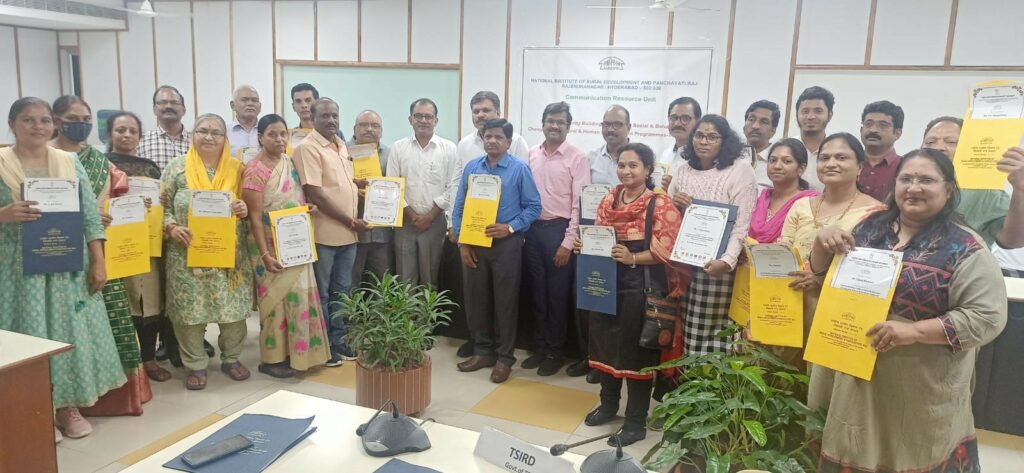
The Centre for Gender Studies and Development and Communication Resource Unit, National Institute of Rural Development and Panchayati Raj, organised two training programmes on the ‘Role of SBCC in Rural & Human Development’ for State Institute(s) of Rural Development from 28th – 29th December 2022 in collaboration with UNICEF at NIRDPR, Hyderabad. These two training programmes were attended by 50 participants (faculty members and training officials) from Andhra Pradesh and Telangana SIRDs. The main aim of these training programmes was to enhance the knowledge and understanding of SIRD faculty on SBCC approaches, processes and tools and thereby guide the SIRDs for integrating SBCC into their respective training approach and methodology.
In her welcome address, N. V. Madhuri, Head, CRU, highlighted the importance of social and behaviour change communication (SBCC) in rural and human development programmes. She described the role of SIRDs as the incubators for SBCC and reminded the participants of their role in being catalysts for social and behaviour change and community engagement in rural and human development. She added that it is important to link SBCC for rural development with a special focus on women and children by SIRDs.
On the first day of the training programme, participants were oriented on the process of behaviour change and various models of behaviour change, such as health belief, theory of planned behaviour, stages of change model, social learning theory, and diffusion of innovations. A functioning model of the behaviour change process was also discussed. They were also oriented on the concept of SBCC, socioecological model, and other approaches and tools for SBC.
In the later sessions, participants were familiarised with the barriers and facilitators to behaviour change. They understood various social constructs through a pattern of behaviour. They further looked at gender-aware programming and ways to integrate gender transformative approaches in the realm of SIRDs.
During the sessions, the theoretical concepts related to behaviour change processes were broken down into simple steps for better understanding using several participatory activities/games. Participants demonstrated great enthusiasm during the group activities.

On the second day of the training programme, the sessions looked at various government initiatives aimed at rural and human development that have incorporated SBCC as a major component of the scheme design and implementation process. Localisation of SDGs and Social and Behaviour Change were also discussed. The two training programmes also focused on showcasing various case studies and innovations in the sectors of WASH, Health and Nutrition where SBCC interventions played a significant role in facilitating behavioural change.
Towards the end of the training programme, participants explored different ways in which SBCC could be integrated/mainstreamed at the SIRD level in terms of capacity development and programmatic planning.
The two training programmes were coordinated by Dr. Vanishree J. and Dr. N. V. Madhuri. Various sessions of the training programme were facilitated by Dr. N. V. Madhuri, Head, CRU, NIRDPR, Shri Subba Reddy, Consultant UNICEF, Shri Kishore Kumar, Consultant, UNICEF, Shri Kulandai Raj, Consultant, UNICEF, Shri V. Varun Kumar, Consultant, UNICEF, Dr. Anjan Kumar Bhanja, Associate Professor and Head, CPRDP&SSD, Shri Muhammed Taquidhin, Consultant, CPRDP&SSD, Ms. A. Shruti, CRU-SBCC Coordinator (Planning & Coordination), NIRDPR and Ms. K. Sreeja, CRU-SBCC Coordinator (Training & Knowledge Management), NIRDPR.
NIRDPR Observes 66th Mahaparinirvan Diwas
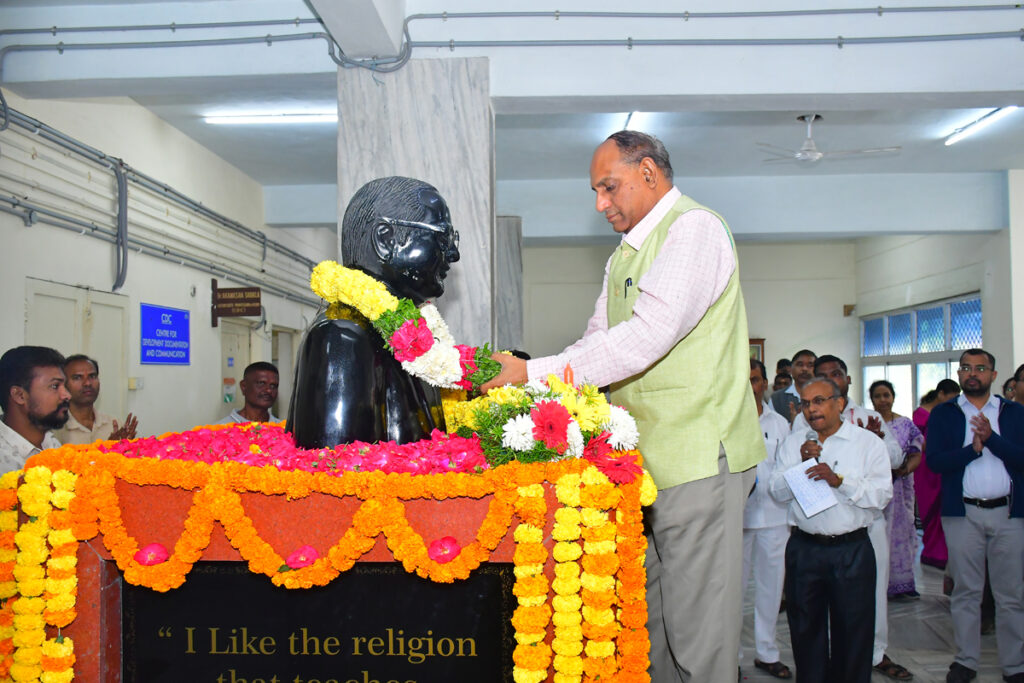
The National Institute of Rural Development and Panchayati Raj, Hyderabad observed Mahaparinirvan Diwas on 6th December 2023, marking the 66th death anniversary of Dr. Bheemrao Ramji Ambedkar, the father of the Indian Constitution.
Dr. G. Narendra Kumar, IAS, Director General, NIRDPR garlanded the bust of Dr. B. R. Ambedkar in Dr. B. R. Ambedkar Block on the Institute premises. Following him, faculty, non-academic members and other officials offered their floral tributes.
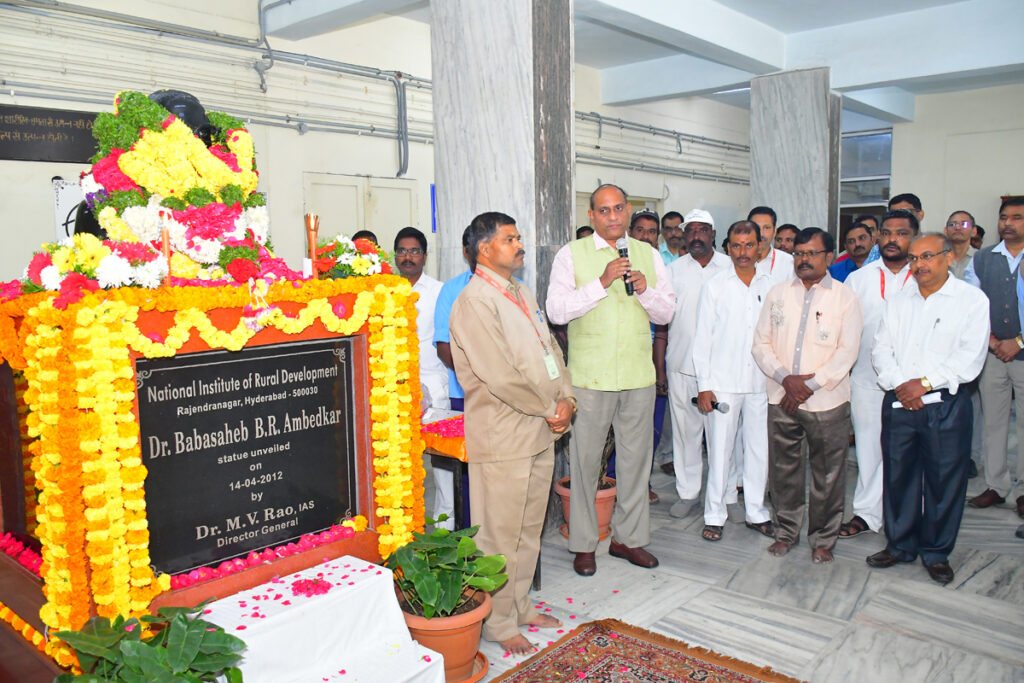
Addressing the gathering on the occasion, the Director General recollected the key roles played by Dr. Ambedkar in framing the Constitution of India.
“He was vocal about social justice and equity reaching all citizens of this country. Development should reach every nook and corner of the country, and NIRDPR is striving to develop new training programmes and address various issues faced by the rural people in tandem with the efforts of the Indian government. All the centres in NIRDPR working towards the upliftment of the downtrodden is the real tribute paid to Dr. Ambedkar,” he added.
The video link of the event is provided below:
CAS, CEDFI Organise Training Programme on Strategies for Formalisation of Rural Informal Sector
The Centre for Agrarian Studies (CAS) & Centre for Entrepreneurship Development and Financial Inclusion (CEDFI), National Institute of Rural Development and Panchayati Raj jointly organised a training programme on ‘Strategies for Formalisation of Rural Informal Sector’ from 12th – 16th December 2022.
More than 80 per cent of rural India’s employed population earn their livelihoods in the informal economy. A preponderant majority of non-agricultural enterprises are part of the informal sector. These units and workers operate outside the ambit of formal institutional setup. Informal workers and units, although contribute to economic and social development, are not protected, regulated, well-recognised or valued. This leaves a majority of informal economy workers and their families outside the benefit of public policy. The vulnerability of informal workers and enterprises has further worsened due to the pandemic and subsequent lockdown. To ensure employment generation at rising levels of productivity, skill development of entrepreneurs and workers engaged therein will be crucial.
Of late, the Central Government has embraced the promotion of a formalisation drive, both for enterprises and workers with ever greater enthusiasm. A series of policy initiatives such as Goods and Service Tax (GST), demonetisation, reforms in banking transactions, the ease of doing business, direct benefit transfers (DBT), digital and fintech payment solutions and ICT/digitisation have been rolled out in an attempt to transcend informal enterprises and workers to a formal setup and improve their accessibility to formal institutions and improve their livelihood status. Towards formalising labour and employment, portals such as Udyam portal, e-Shram, NCS and ASEEM have been created to address the issues of jobs, skills, social security, etc. However, these initiatives have not only created opportunities but also thrown challenges, threats and apprehensions.
In this context, the said training programme was conducted jointly by CAS and CEDFI to capacitate a diverse cadre of RD and PR functionaries to upgrade their knowledge and approaches to understand different dimensions of formalisation, i.e., how an enabling environment can be created to encourage both informal workers and enterprises to be part of the formal institutional network and gain from these institutions. A total of 28 participants from 10 States, namely Andhra Pradesh, Kerala, Maharashtra, Odisha, Tamil Nadu, Uttar Pradesh, Himachal Pradesh, Bihar, Gujarat and Telangana participated in this programme. These participants were from different State Rural Livelihood Mission(s), State Rural Development departments, faculty and directors of RSETIs, young professionals and fellows.

During the five-day training programme, an in-depth discussion was carried out on various topics, including, Role and Relevance of Rural Informal Sector in India, Contemporary Challenges for Rural Informal Sector: Possibilities for Formalisation, Challenges for Informal Sector: Strategies and Options for Improvement, Role of Skilling in Formalisation Process, Aggregation Models in Agriculture: Case of FPOs, Gender Issues and Informal Economy, Strategies for Informal Sector in a GST Regime, Formalisation: Government Schemes and Programmes, Informal Sector Development: Case of Agricultural Value Chains, Good Intervention Carried Out by SERP, Telangana, Financial Inclusion, Financial Literacy and Entrepreneurship – Going Digital and so on. To engage participants, a group discussion was also arranged on various pathways of formalisation, such as marketing, digitisation, role of collectives, skilling, training and capacity building. A full session was spent to understand the needs and expectations of all participants. Pre- and post-tests were also conducted to assess the impacts of this training programme on the learning outcome of participants.

To supplement the classroom discussion and exposure visit to Sid’s Farm in Tallapally, Telangana was arranged. Participants gained first-hand experience of a fully mechanised modern dairy unit, use of new technology, skilled workers, improved working conditions, availability of basic services and utilities, and compliance with various government regulations on quality, safety and standardisation of products. Sid’s Farm has managed to create a niche market for its products, i.e., milk, curd, buttermilk, ghee, sweets etc. At Sid’s Farm, the participants got to know the application of formalisation initiatives. The exposure visit was appreciated by all our participants.
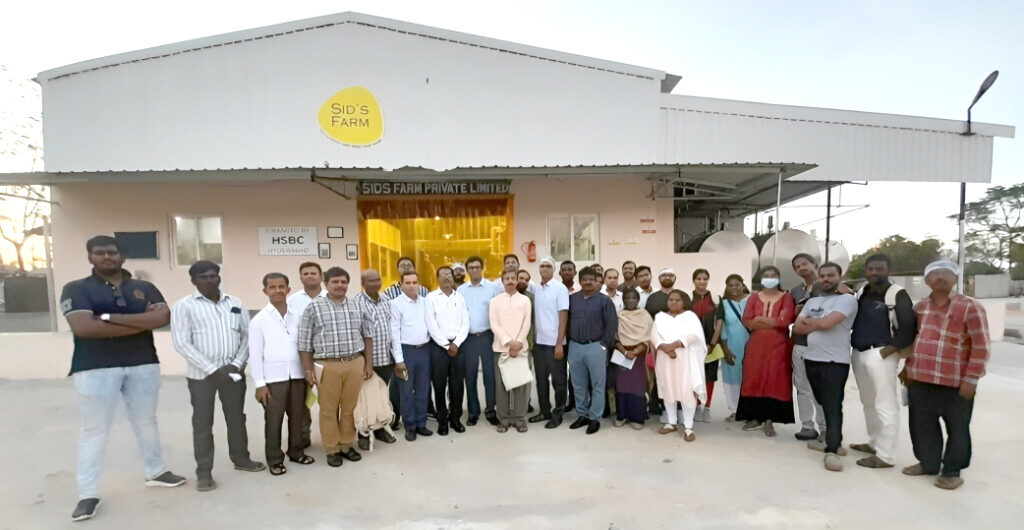
All the sessions were conducted in an interactive and participatory mode in order to keep participants fully engaged. In the last session, detailed feedback was collected from the participants on the online Training Management Portal and certificates were handed over. They also shared their experiences of the five-day training programme and areas having scope and possibilities for further improvement in the subsequent training programmes. Based on the feedback from the participants and resource persons, it may be concluded that the said programme was satisfactory in all respects and the objectives and goals envisaged in the programme were duly realised. The training programme was jointly co-ordinated by Dr. Surjit Vikraman, CAS and Dr. Partha Pratim Sahu, CEDFI, NIRDPR.
Good Governance Week: Prashasan Gaon Ki Aur Campaign
The Government of India, in its journey towards Vision India @2047, has emphasised ‘Rural Regeneration’ to achieve an outcome-based approach to asses real development on the ground and to deliver benefits to the last person in the queue for which good governance is the key. A good governance system must ensure that the development benefits must reach the remotest citizen living in the remotest villages of India. The Good Governance Day (observed in memory of former Prime Minister Bharat Ratna Late Atal Bihari Vajpayee) and Good Governance Week are being celebrated to create a national movement for good governance.

Good Governance Week was celebrated from 19th -25th December 2022, with a nationwide launch of ‘Prashasan Gaon Ki Aur’ (Governance towards Village) campaign. For the inclusive and sustainable development of rural India, government schemes and programmes must take into account the needs and aspirations of the people in the true bottom-up approach and should be implemented through the latest technological tools in a transparent, effective and accountable manner. Several activities were planned under this special campaign. An innovative and far-reaching step has been taken for involving a retired District Collector (DC)/District Magistrate (DM) of a district in preparation of the vision document of the district for the year 2047, District @100. All the districts of the country must leverage their inherent strengths with an aim to develop a focused approach.
‘Prashasan Gaon Ki Aur’ 2022 is a nationwide campaign for redressal of public grievances and improving service delivery which will be carried out in all districts, States, and Union Territories of India. Over 700 District Collectors are participating in ‘Prashasan Gaon Ki Aur’ 2022. Under this campaign, District Collectors will organise a workshop on ‘Good Governance Practices/Initiatives’ and make efforts to outline a vision for the district with inputs of a retired IAS, who has served as DC/DM in the District but retired as well as from academicians and think-tanks of leading educational institutions. Under the Vision Document District@100, the districts will be defining the vision/goals for the district for the year 2047. It is expected that the administrative experience of the retired DC/DM, academicians, think-tanks combined with the energy of the current DC/DM will define and produce a visionary document for the district for its path ahead in the journey of inclusive and sustainable development.
The main focus of this initiative is to expand and make available citizen-centric services to the doorsteps of citizens through a comprehensive digitisation policy and to reduce the rural-urban divides. A series of special camps/events are to be organised at Tehsil/Panchayat Samiti level to resolve public grievances and for improved service delivery. Under the One Nation-One Portal vision, efforts are being made to link all the respective State/IT portals with the Centralised Public Grievance Redress and Monitoring System (CPGRAMS). Since grievance redressal is a critical ingredient of good governance, all citizens’ voices must be heard, and their grievances must be redressed within a specified time period. Towards this, the CPGRAMS has adopted a 10-point reform which has ensured a significant reduction in grievance redressal time and improvement in quality of disposal. More than 80 per cent of grievances in government are being filed online and with the help of Artificial Intelligence and Machine Learning, the CPGRAMS portal is in a position to identify grievances and officer-wise pendency in the country. More than 3000 new government services identified by District Collectors across the country will be added for online service delivery during the 5-day campaign. During this campaign, several best good governance practices have been identified for discussion in district-level workshops. Many success stories in public grievances are also planned to be shared during the Good Governance Week-2022.
For such a campaign to deliver the desired outcomes, all stakeholders must participate unitedly and contribute with greater conviction and commitment. In the emerging discussion on the Localisation of Sustainable Development Goals (L-SDG), in which ‘Village with Good Governance’ is one of the nine themes and a cross-cutting theme, the role of local institutions such as Panchayat will be crucial. Panchayati Raj Institutions, being the last mile institutions, can play a significant role in promoting good governance practices, with support from various stakeholders and create an ecosystem for the implementation of good governance practices and ensure better service delivery. Panchayats should also make due efforts to sensitise rural people about new programmes and schemes as well as on rights and entitlements. Special Gram Sabhas may be conducted to flag up and discuss issues on governance, inviting all relevant officials from different line departments, and representatives from youth clubs, schools and colleges. The Gram Panchayat Development Plan (GPDP) can play a direct role in identifying issues related to governance, accountability and transparency and devise a mechanism to resolve them amicably. Provisioning of digital devices at subsidised rates and installing a computer in the Panchayat office or any community centre can help connect all citizens, especially the poor, with various government schemes and programmes and also help them to get access to support measures available on IT- enabled portals or dashboards.
Good governance must put people at the centre of the development process. To move faster in the path of good governance, locally-driven processes are to be explored to find solutions to governance challenges. Digital empowerment of all citizens, training and capacity development of all elected representatives and RD & PR functionaries, and improved rural connectivity (i.e., roads, phones, internet, and social media) will be crucial to reorient the mindset of all stakeholders towards good governance practices.
Note: It liberally draws from Press Information Bureau note on Good Governance Week, 19 December 2022 and various newspaper articles on this subject.
Dr. Partha Pratim Sahu
Associate Professor and Head (i/c),
Centre for Good Governance and Policy Analysis (CGGPA), NIRDPR
Orientation by EPW Research Foundation on India Time Series Database
An orientation programme by the Economic and Political Weekly Research Foundation on using the EPW Research Foundation India Times Series (EPWRFITS) database was organised at the Institute on 1st December 2022.
Dr. Bipin. K. Deokar, Senior Deputy Director, EPW Research Foundation took a session on the 21 modules present in the time series. Dr. Deokar gave a detailed picture of how to access the EPWRFITS and dig data by using these tools. He demonstrated how the data collected by the organisation is uploaded on the site according to the modules, States and districts. This was followed by a question-and-answer session.
The programme was graced by Prof. Jyothis Sathyapalan, Head, Centre for Development Documentation & Communication, Dr. M. Srikanth, Registrar and Director (Admin), centre heads, faculty and students of the Institute.
NIRDPR Official Attends International Programme on Management Strategies for Sustainability of CFIs
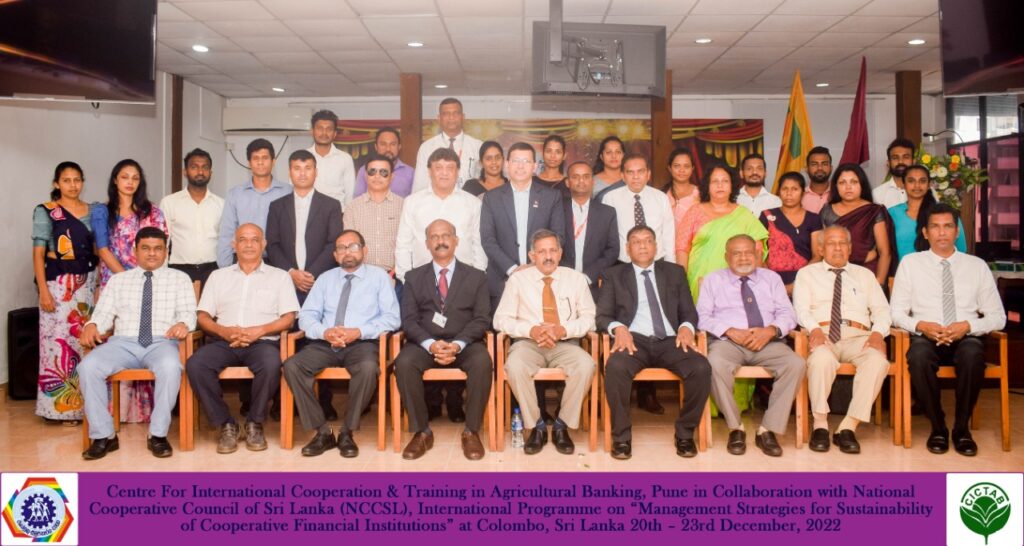
The Centre for International Cooperation and Training in Agricultural Banking (CICTAB), Pune in Collaboration with the Department of Cooperative Development, Government of Sri Lanka organised an international programme on ‘Management Strategies for Sustainability of Cooperative Financial Institutions (CFIs)’ in Colombo, Sri Lanka from 20th – 23rd December 2022. Dr. Venkatamallu Thadaboina, Research Officer, CRTCN, NIRDPR represented the National Institute of Rural Development and Panchayati Raj in this event.
The objectives of the programme included sensitising the participants about the regulatory mechanism of cooperative financial societies and strategic management processes, familiarising the participants with the use of management strategies for the sustainability of cooperative financial institutions, and sharing the best practices of governance.
The programme was conducted through interactive sessions and a one-day field visit to the institutions following the best practices for a better understanding of the existing system of cooperative financial institutions in Sri Lanka.
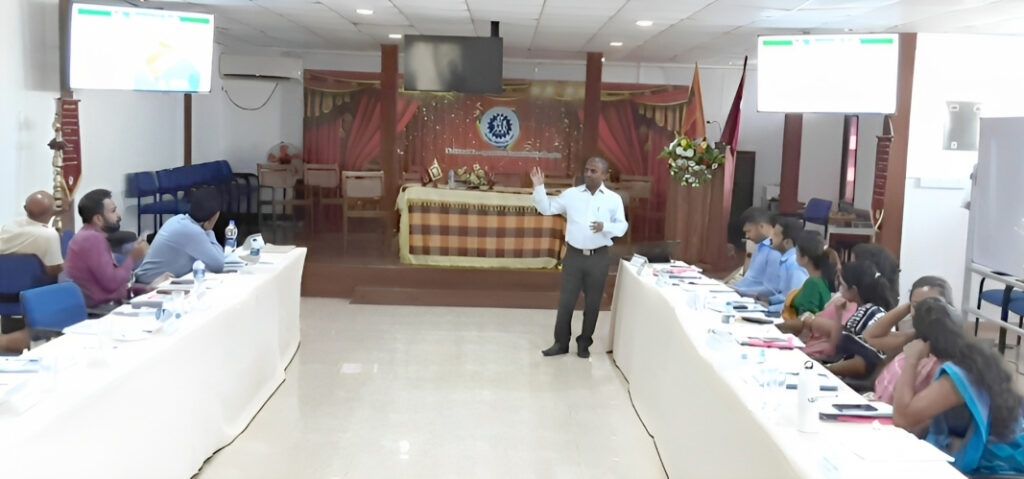
The technical sessions majorly focused on the overview of the Cooperative system in Sri Lanka, Best Practices of Financial Cooperatives in Sri Lanka, and Managerial tools for decision-making. The participants, representing different organisations from India, Nepal and Sri Lanka, made the presentations majorly focusing on overview of the rural development scenario in the country and the activities of the institutions they represented.
The participants were taken to two best-performing institutions, namely Bingiriya Multipurpose Cooperative Society and Marawala SANASA. The exposure visit gave the participants a chance to interact with the functionaries of the financial institutions to understand the governance structure and activities of the institution, and the role of these institutions in national development through the core services such as providing credit support for farming and non-farming activities to enhance the production and encourage livelihoods activities at the grassroots level. During the field visit, the participants collected first-hand information on the activities of multipurpose cooperative institutions in the economic and social development of the rural people in Sri Lanka.
Four technical sessions that covered themes such as Good Governance for Cooperative Financial institutions, Importance of Marketing Strategies for Cooperative Sector, Strategic Institutional Development of Community-based Financial Institutions, and Digitisation of Cooperatives for Financial and Non-Financial Value Chain Development, were conducted.
The technical sessions majorly focused on developing the income generating activities for cooperatives and digital Innovations in banking and finance cooperatives. The participants were divided into three groups, and each group brainstormed to prepare the action plan with management strategies for the sustainability of cooperative financial institutions and presented it in the forum. Overall, the programme was informative, and the participants got an opportunity to understand the role of cooperative sector in rural development and rural governance system in Sri Lanka. The programme was attended by 24 participants, including three each from India and Nepal and the remaining from Sri Lanka.
Dr. Venkatamallu Thadaboina
Research Officer, CRTCN, NIRDPR
Five-day Training Programme on Farmer Producer Organisations in Bamboo Sector
Bamboo is one of the most versatile and fastest-growing plant species. Multifarious uses of bamboo have the potential to contribute to the ecological, economic and livelihood security of the people. India has the highest area under bamboo and is the second richest country, after China, in terms of bamboo diversity, with 136 species (125 indigenous and 11 exotic) (NBM, 2019). The bamboo industry in India is worth nearly Rs 30,000 crore (2021). The export of bamboo & bamboo products was Rs. 0.32 crore, whereas the import was Rs 213.65 crore during 2016-17. Despite the growing stock within and outside forests, India is a net importer of bamboo (NBM, 2019). Therefore, there is a greater opportunity to harness the market potential by increasing its production and establishing a proper value chain ecosystem by bringing together all the key stakeholders to improve the rural economy.
It has been noted that in the earlier efforts, there was an absence of a linkage between the producers (farmers) and the industry with a strong value addition component, and also weak efforts in organising bamboo farmers for aggregation through institutions such as cooperatives, SHGs, JLGs, etc. Hence the emphasis in the restructured NBM 2018-19 is on the propagation of quality plantations of bamboo of the commercially required species, product development and value addition, including primary processing and treatment, micro, small & medium enterprises as well as high-value products, markets, and skill development, thus ensuring a complete value chain for growth of the bamboo sector to boost bamboo-based industry. This would also have a ripple effect on the rural economy. Overall, bamboo cultivation and bamboo-based products are gaining importance in the context of sustainable rural development strategies, and there is an increased demand for bamboo-based products. It is suggested as an alternative crop for improving farmers’ income, part of climate adaptation strategies due to high carbon sequestration potential, enormous scope to develop entrepreneurship around bamboo-based products and creation of rural employment opportunities, and a high potential for a bamboo-based livelihood development model.
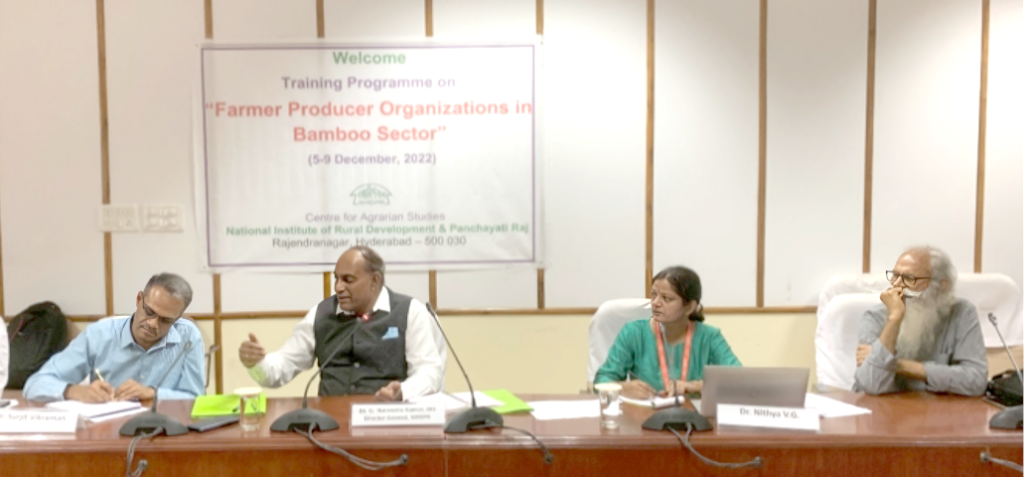
In this context, the Centre for Agrarian Studies of NIRDPR, Hyderabad organised a training programme on ‘Farmer Producer Organisations in Bamboo Sector’ from 5th to 9th December 2022 on the campus. The major objectives of the programme were a) to make the participants understand the potential of the bamboo sector in improving rural livelihoods through entrepreneurship and skill development, b)to familiarise how FPOs can utilise opportunities in this sector to improve rural livelihoods, c) familiarise FPOs with innovative products of bamboo and marketing opportunities, d) marketing and value chain development strategies for FPOs in bamboo sector, and e) innovations in bamboo value addition for rural economy and entrepreneurship.
Dr. G. Narendra Kumar, IAS, Director General, NIRDPR delivered the inaugural address, highlighting the importance of bamboo from the economic, ecological and social security points of view. He also emphasised the importance of FPOs and their potential as collectives to address the various inputs and output market constraints faced by the cultivators in rural areas and has greater potential to harness the market opportunities by increasing its production and value addition. The government is also promoting FPOs as a strategy to increase the income level of farming community. Along with FPOs, SHGs also play a major role in community-based institutions for improving rural livelihoods. The potential of bamboo and its products and the collective strength FPOs and SHGs as institutions can significantly contribute to improving rural livelihoods through entrepreneurship and skills. Identifying and building a proper value chain ecosystem based on bamboo products by bringing together FPOs, SHGs, and other key stakeholders can contribute to improving the rural economy.

The training programme had sessions on various aspects of bamboo, viz. Bamboo Farming for Sustainable Agriculture, Cultivation and Production Technologies of Bamboo in India, Innovations in Bamboo Processing and Product Manufacturing, Developing Market Linkages and Marketing Strategies for Bamboo Products, Innovative and Diverse Uses of Bamboo & Value Addition and Opportunities in Bamboo-based Products, Bamboo-based Construction for Rural and Agricultural Infrastructure, Credit Support and Potential for FPOs in Bamboo Sector, Entrepreneurship Development Opportunities for FPOs in Bamboo Sector, etc. These sessions were handled by eminent resource persons, including Dr. Ajay Thakur from Forest Research Institute, Dehradun, Dr. A.V. Ramanjaneyulu and Dr. B. Joseph from PJTSAU, Prof. Sudhakar Puttagunta, Professor (Retd.), IIT Delhi, Shri Ranganath Krishnan, Shri Sanjeev Shashikant Karpe, KONBAC, Prof. Chaaruchandra Korde, IIT Delhi, Shri STS Lepcha, IFS, and Shri T. K. Sahoo.

The participants were divided into groups on the final day to work on Business Plan Development on Bamboo Value Chain, and they presented their plans for implementation. The participants were taken on an exposure visit to the Phoenix Foundation, located at Logda village of Latur district, Maharashtra. Participants were familiarised with various activities of the bamboo value chain, starting from the production of seedlings through tissue culture methods, distribution of seedlings, establishment of bamboo plantations, manufacturing of furniture and lifestyle products from bamboo. The exposure to various processes of furniture making and lifestyle products from bamboo after processing was insightful for the participants and gave them confidence to adopt value addition opportunities using bamboo.
The training was attended by 20 participants representing line functionaries of rural development departments of State governments, SRLMs and representatives of FPOs from Tripura, Meghalaya, Kerala, Telangana, Andhra Pradesh, Maharashtra, Karnataka, Madhya Pradesh and Tamil Nadu. The training was coordinated by Dr. Nithya V. G. Assistant Prof., CAS and Dr. Surjit Vikraman, Head and Associate Prof., CAS.
CDC, CPGS Organise Workshop on FDP for Audio-visual Means for Case Studies and Best Practices in RD&PR
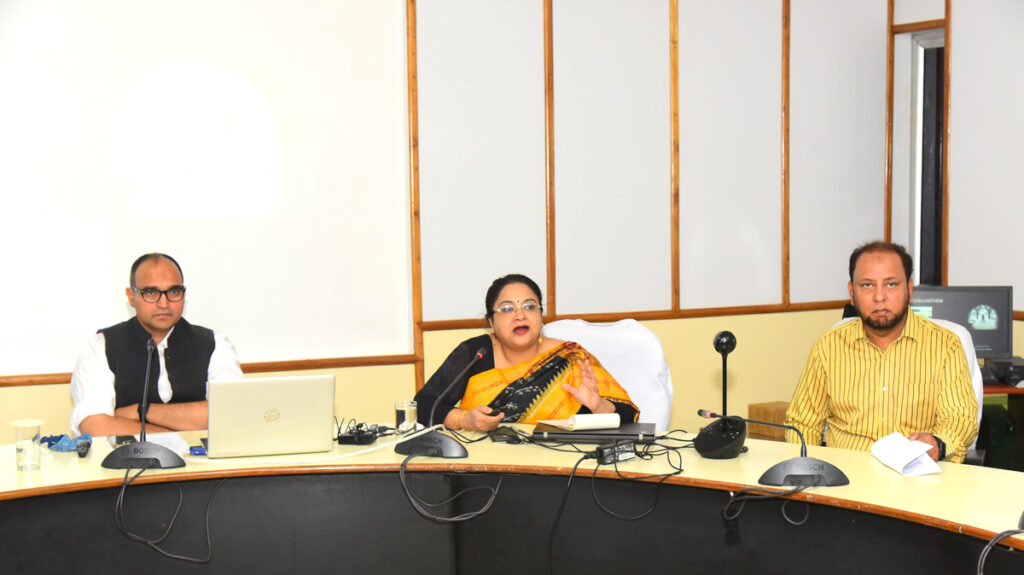
The Centre for Development Documentation & Communication (CDC) and the Centre for Post Graduate Studies & Distance Education (CPGS&DE), NIRDPR jointly organised a two-day workshop on ‘FDP for Audio-visual Means for Case Studies and Best Practices in RD&PR’ from 27th – 28th December 2022.
Mr. Rizwan Ahmad, Director, Instructional Media Centre, Maulana Azad National Urdu University, Hyderabad was the resource person for the programme.
Dr. Akanksha Shukla, Associate Professor, CPGS&DE and Workshop Coordinator, welcomed Mr. Rizwan Ahmad and the participants. Mr. Rizwan Ahmad, Dr. Akanksha Shukla and crew started the first day of the workshop with a session on ‘The Idea of Storytelling.’ Further, Mr. Rizwan Ahmad and his team handled sessions on ‘Introduction to Fundamental Technologies,’ ‘Photography/Videography Using Smartphone,’ ‘Techniques and Application of Filmmaking’, and ‘Artistic & Aesthetic Analysis of Films.’
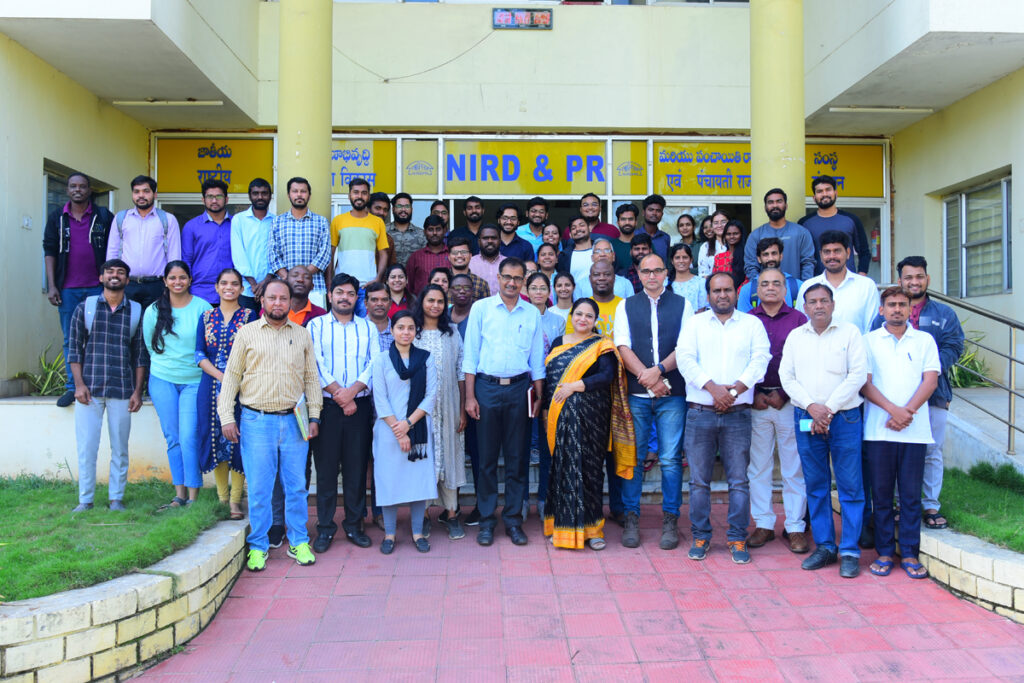
The workshop was very interactive, and it drew a lot of applause as a number of small movies were screened, and demonstrations were made on different equipment to be used while on the field to make a documentary using a smartphone. It also emphasised on the usage of light, sound and various camera angles. Specific emphasis was assigned to the overall initiation, body and conclusion of the story whether told in a minute or for an hour.
A total of 37 participants, including faculty members, non-academic staff and students, attended the workshop. Besides, several participants from the North Eastern States, who are associated with the National Rural Livelihoods Mission, attended the programme online.
As the fallout of the workshop, about 37 movies were made with NIRDPR and CPGS&DE programmes as the main themes. According to the feedback, the workshop has benefited the students of the postgraduate diploma programmes as well as the NRLM team and non-academic members of NIRDPR.
Dr. Akanksha Shukla coordinated the workshop with the assistance of Dr. Jyothis Sathyapalan, Prof. & Head, CDC and CDC staff Mr. Syed Ashfaque Hussain, UDC and Ms. Anupama Khera, Documentation Officer.
NIRDPR Hosts Workshop on Sustainable Use of Biodiversity at the Local Level
The National Institute of Rural Development & Panchayati Raj organised a workshop on ‘Sustainable Use of Biodiversity at the Local Level’ with the agenda of initiating a dialogue in this direction. The workshop organised by the task force on scenarios and models took place on 30th December 2022. Prof. Jyothis Sathyapalan, Professor & Head, Centre for Development Documentation and Communication/Centre for Post Graduate Studies & Distance Education (CPGS & DE) and Dr. G. V. Krishna Lohi Das, Assistant Professor, Centre for Wage Employment and &Labour (CWE&L) organised the workshop. Dr. Nalini Mohan, IFS, Dr. B. M. K. Reddy, ARS, Shri G. B. K. Rao, Chairman and Managing Director, Pragati Sudama Resorts Limited, Ms. Salomi Yesudas, Academician and Dr. K. Jyothi, Scientist, EPRI were the resource persons.
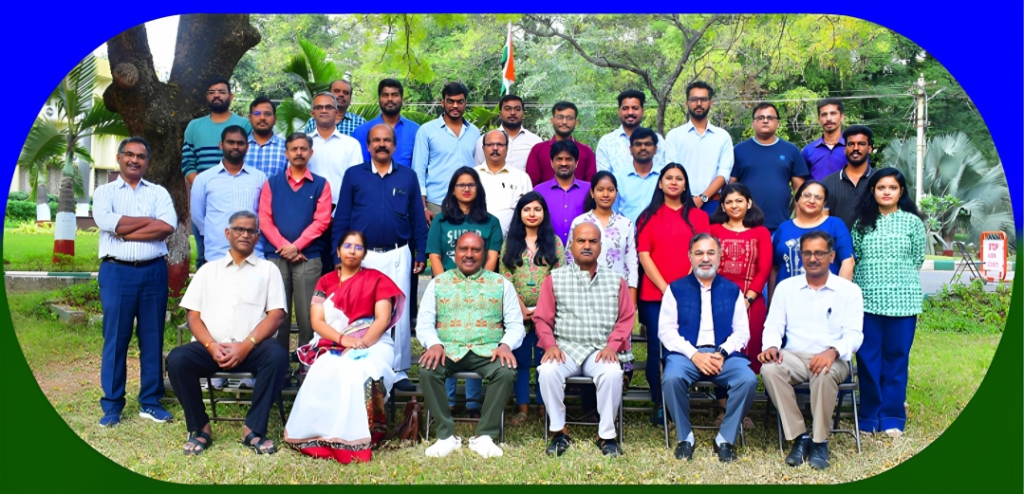
The objectives of the workshop were i) to catalyse further development of scenarios and models, ii) to have a constructive discussion with the stakeholders about the different aspects and drawbacks of implementing the National Biodiversity Act 2002, and iii) to add more angles like agro-biodiversity and uncultivated food resources to the transformative change dialogue.
The workshop started with a welcome address by Dr. Jyothis Sathyapalan and the floor was opened for discussion with a brief introduction on its agenda.
Dr. Nalini Mohan, IFS started the day’s agenda with a detailed discussion on the National Biodiversity Act, 2002. Talking about the endangered species in Andhra Pradesh and their significance for the ecosystem, Dr. Nalini Mohan briefed the participants about the significant steps taken by the government to conserve the endangered species.
Biodiversity Act: Issues, Challenges and Need for Capacity Building
Dr. B. M. K. Reddy, ARS initiated the discussion on the major issues faced at the implementation stages at the Panchayati level. He spoke about the complexities of forming Biodiversity Management Committees at the district level and the institutional shortcomings involved in the process. Briefing the participants about the significance of making People’s Biodiversity Register at the Panchayat level, he highlighted the value of indigenous knowledge and processes, and the importance of documenting it in the most detailed manner. Dr. B. M. K. Reddy also talked about the lack of skilled workforce who can mobilise the indigenous tribe to share the right knowledge and due process of any medicinal herb species.
Face of Business in Biodiversity
Shri G. B. K. Rao was the resource person for the third segment of the workshop on the role of business & micro-enterprises in biodiversity conservation. Being the Chairman and Managing Director of Pragati Sudama Resorts in Hyderabad, he explained how the wasteland bought for business was transformed into an occupational space. Taking the establishment of Pragati Sudama Resorts as a case study, Shri G. B. K. Rao told the participants about the ‘Pragati Model’ and the biodiversity conservation activities he practised to carve a business out of it. He mentioned the ayurvedic medicinal herbs and plants grown at Pragati and added how the actions taken over the years are finally bearing fruits. He talked about incentive-based biodiversity conservation drives and briefed the participants about various sustainable land restoration practices.
Agro Biodiversity: Food Security and Nutrition
The session on Agro Biodiversity & Food Security was taken by Ms. Salomi Yesudas. She gave a detailed and data-driven presentation on the sources, needs and significance of the ‘uncultivated foods.’ It offered a different yet insightful angle to the whole conversation on the “sustainable use of biodiversity at the local level.” Ms. Salomi introduced the concept of a ‘dietary register’ for the ‘uncultivated foods.’ Educating the participants about various micronutrients easily available in the ‘uncultivated foods,’ she said they are the most sustainable solution to the complex problem of ‘world hunger.’
Dr. K. Jyothi, Scientist, EPRI spoke about the challenges one faces while preparing people’s biodiversity register. Giving a basic introduction to the National Biodiversity Act 2002, she explained its significance and the relevance of indigenous knowledge for the effective implementation of the Act. She also described the structure of Biodiversity Management committees, and its functions and significance.
Identification of the flora of the campus for Geo-tagging
The last part of the workshop was identifying different flora available on the NIRDPR campus and documenting their medicinal and dietary use. During this exercise, Ms. Salomi Yesudas presented different herbs and plants, and briefed the participants about their medicinal use. Prof. Jyothis Sathyapalan and Dr. G. V. Krishna Lohi Das attended the plenary and valedictory sessions.
